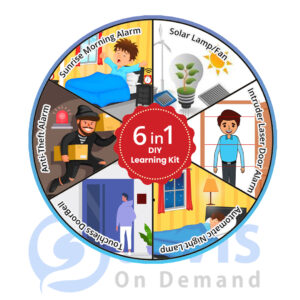Description
If you are a senior student looking for a fun and challenging DIY project, look no further than our “5 in 1 DIY Project for Senior Students.” Our project is designed to provide you with a range of exciting and educational activities that will help you develop your problem-solving skills and creativity.
With our step-by-step instructions and easy-to-follow guides, you will be able to build five different projects, including a Mini Weather Station, Remote Control Appliance, Heart Rate Monitor, etc. Each project is designed to be both engaging and informative, allowing you to explore various fields of science and technology.
By participating in our “5 in 1 DIY Project for Senior Students,” you will not only have fun and learn new skills, but also enhance your resume and impress potential employers or university admissions committees. So why wait? Start your DIY adventure today and discover the joys of hands-on learning!
| Project Name | Component Name | Quantity |
| Heart Rate Detector | Wemos D1 Mini | 1 |
| Remote Control Apaliance | DHT11 | 1 |
| Touch Switch | 1 | |
| Weather Control Switch | Heart Rate Sensor | 1 |
| Weather Station | Remote Control Sensor | 1 |
| Relay | 1 | |
| Touch Switch | 1 | |
| Bread Board | 1 | |
| Wire | 30 | |
| USB Cable | 1 |
Here are some potential benefits that DIY projects can offer:
- Hands-on learning: DIY projects allow students to learn by doing, which can be a more engaging and memorable way of learning than simply reading about a topic.
- Skill development: Depending on the nature of the project, students may develop skills in areas such as woodworking, electronics, programming, or design.
- Creativity: DIY projects often involve problem-solving and innovation, which can foster creativity and encourage students to think outside the box.
- Sense of accomplishment: Completing a DIY project can give students a sense of pride and accomplishment, which can help build self-esteem and confidence.
- Practical application: DIY projects can be a way to apply academic knowledge to real-world situations, helping students see the relevance of what they are learning.
- Collaboration: Depending on the project, students may work in groups or pairs, which can improve their collaboration and communication skills.






Reviews
There are no reviews yet.